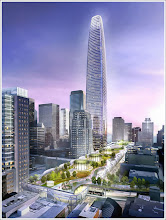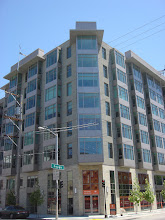Ask anybody who lives in an urban environment if they ever had a close call with a car or truck while attempting to walk across the street and chances are they will have more than one anecdote. Unfortunately, most of us have accepted that being a pedestrian in San Francisco comes with the added thrill of taking your life in your hands once you step off the curb.
Drivers aren't the only culprits. Every week I see people stepping into the street engrossed in their mobile phones without a single glance toward oncoming traffic. It seems they expect the cars, buses and trucks will slow or stop to allow them to cross, unscathed. Never mind that the drivers too, are engrossed in their mobile phones or checking their teeth in the rear-view mirror.
With these scenarios in mind, New York City's Transportation Commissioner completed an ambitious project Sunday that closed two sections of Broadway to vehicles from 47th to 42nd Streets in Times Square and 35th to 33rd Streets in Herald Square. Her goals are twofold: improve traffic flow in these otherwise gridlocked locations by routing traffic to cross streets and the creation of broad pedestrian plazas in two of Manhattans most celebrated and crowded urban gathering places. The plan has its share of critics but it's hard to argue with a scheme that carves public open space out of dense, built- out areas without the loss of public or private property.
Can San Francisco take a cue from The Big Apple by appropriating sections of our streets and giving them back to residents and visitors who will actually use them ? Or is maintaining the full length of Market, Mission, Howard, Folsom, Harrison, Bryant, Brannan and Townsend Streets for SUV's speeding toward the Bay Bridge the best use of these unrecognized resources ?
There have been plans floating around City Hall since the 1960's to close some or all of Market Street (San Francisco's Broadway) to vehicular traffic. Each time a new plan surfaces, it gets shot down by merchant groups claiming that closing the street will hurt their business by impeding the flow of customers and delivery trucks. As one ponders the public transit already in place and the primarily retail and office uses of buildings along Market, it's hard to fathom that this scheme would do anything but draw more people to patronize these businesses.
San Francisco has however, planned for a new and improved Folsom Street Corridor from The Embarcadero to Second Street. The approved plan includes widening sidewalks, planting trees and other traffic calming measures that will take back part of the street for pedestrians. The plan looks good on paper but the reality is that "Folsom Boulevard" as envisioned won't happen for at least another ten years or whenever the new TransBay Terminal, Tower and related construction is complete.
It's not all doom and gloom, though, for those who can envision Downtown transformed into a safer, more human-focused environment. When the various neighborhood farmers' markets and street fairs take place, we get a short taste of what life could be like when parts of our busy streets are closed. Vendors set up shop, people sit, shop, strut, mingle and, for a few hours, a neighborhood becomes a place for it's residents and visitors to savor and experience without noise, fumes and risk.
It sure beats the life-threatening gamble of calculating whether or not that MUNI bus barreling toward you is going to run the red light or not.
Thinking about buying or selling Downtown ? You owe it to yourself to consult an expert. I'm happy to discuss your real estate goals, no obligation.
Thanks for reading; see you next week.
Subscribe to:
Comments (Atom)
















































